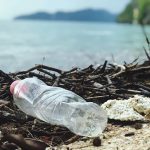Did you know that an estimated 35% of microplastics in the ocean come from synthetic textiles? Each time you wash these clothes, tiny fibers shed and end up in waterways, posing serious risks to marine life and, ultimately, human health. As these microplastics accumulate, they disrupt ecosystems and food chains. What are the long-term consequences of this hidden pollution, and how can we address it effectively?
Table of Contents
Key Takeaways
- Microplastics from textiles enter marine environments primarily through laundry wastewater, where they disrupt ecosystems and harm marine life.
- Marine organisms ingest microplastics, leading to digestive issues, inflammation, and reduced reproductive success.
- Toxins associated with microplastics can accumulate in the food chain, potentially impacting human health through seafood consumption.
- Inhalation of microplastics can cause inflammation and hormonal disruption in humans, raising concerns about chronic health issues.
- Sustainable practices, such as using natural fibers and washing machine filters, can mitigate the release of microplastics and protect both marine life and human health.
Prevalence of Microplastics in Our Oceans
Microplastics have become a pervasive issue in our oceans, with estimates suggesting that millions of tons are now floating in marine environments.
You might be surprised to learn that these tiny plastic particles are often less than five millimeters in size, making them difficult to detect. They originate from various sources, including personal care products, plastic waste, and yes, even textiles.
As you explore coastal areas, keep in mind that microplastics can accumulate in the food chain, affecting marine life and, ultimately, human health. Studies show that fish and other sea creatures ingest these particles, leading to potential toxic effects.
Mechanisms of Microplastic Release From Textiles
As you wear and wash your clothes, tiny fibers shed from textiles, contributing significantly to microplastic pollution. This shedding occurs during daily activities, such as putting on or taking off garments, and intensifies in the washing machine.
The mechanical agitation in the wash cycle breaks down synthetic fibers, releasing microplastics into the water. Even a single load can release thousands of fibers, which then escape through wastewater systems.
Furthermore, factors like fabric type, wash temperature, and detergent choices can influence the amount of microplastics released. Natural fibers also shed, though to a lesser extent.
Over time, these microplastics accumulate in the environment, posing potential risks to marine ecosystems and, ultimately, human health. Understanding these mechanisms is vital for addressing the issue.
Impact of Microplastics on Marine Organisms
The shedding of microplastics from textiles not only contributes to pollution but also poses significant threats to marine organisms. When these tiny particles enter oceans, they’re ingested by fish, crustaceans, and other marine life, disrupting their feeding and digestion.
You may not realize that microplastics can accumulate toxins, which then transfer up the food chain, affecting larger species and ultimately humans. Additionally, these particles can cause physical harm, leading to inflammation and reduced reproductive success in marine organisms.
As you dive deeper into the ocean’s ecosystems, consider how this invisible threat impacts biodiversity. By understanding these effects, you can advocate for better practices in textile production and support efforts to reduce microplastic pollution, protecting marine life for future generations.
Human Health Concerns Related to Microplastics
While you might think of microplastics as a problem limited to the environment, they also pose serious risks to human health. These tiny particles can enter your body through various pathways, such as inhalation or ingestion, often found in food and water.
Once inside, they may lead to inflammation, disrupt hormones, and even cause cellular damage. Studies indicate that certain chemicals associated with microplastics can be toxic, potentially increasing the risk of chronic illnesses.
You mightn’t realize it, but the clothes you wear can shed microplastics into the air and water, affecting you indirectly. With ongoing research, scientists are uncovering more about how microplastics impact your health, urging you to stay informed and consider sustainable textile choices.
The Global Distribution of Microplastic Pollution
Microplastics aren’t just a health concern; they’re also a global environmental issue that affects ecosystems worldwide.
You might be surprised to learn that microplastics from textiles can be found in even the most remote areas, from the deepest oceans to the highest mountains. These tiny particles travel through rivers and wind, spreading pollution far and wide.
In coastal regions, marine life ingests these microplastics, mistaking them for food. As you consider the impact, think about how your clothing choices contribute to this crisis. Each wash releases thousands of fibers into waterways.
Understanding the global distribution of microplastics is essential for realizing the scale of the problem. It’s time to take action and reduce our reliance on synthetic textiles for a healthier planet.
Environmental Implications of Microplastics
Microplastics from textiles are spreading across the globe, impacting ecosystems in ways you mightn’t expect.
These tiny particles disrupt food chains and harm wildlife, leading to significant long-term environmental consequences.
It’s essential to understand how these pollutants affect our planet and what we can do about it.
Global Pollution Distribution
As you explore the impact of microplastics, it’s important to understand their global distribution and the environmental implications that arise.
Microplastics from textiles travel far beyond their point of origin, contaminating oceans, rivers, and even remote areas like Arctic ice. They enter waterways through wastewater, where treatment plants often fail to filter them out effectively.
This widespread pollution affects marine ecosystems, as these tiny particles can be ingested by a variety of organisms, from plankton to fish. As you consider these implications, think about how microplastics not only disrupt marine environments but also accumulate in the food chain, ultimately posing risks to human health.
Addressing this issue requires global cooperation and innovative solutions to reduce textile waste and improve filtration systems.
Ecosystem Disruption Effects
While you mightn’t see them with the naked eye, microplastics have a profound impact on ecosystems, disrupting the delicate balance of nature.
These tiny particles infiltrate waterways, affecting aquatic organisms like fish and plankton. When marine life ingests microplastics, it can lead to physical harm, reduced feeding efficiency, and even death.
You may not realize it, but this toxicity can ripple through the food chain, impacting larger predators and eventually humans.
Additionally, microplastics can alter habitats, suffocating corals and affecting plant growth. As these particles accumulate, they can disrupt breeding and migration patterns, threatening biodiversity.
Recognizing these effects is vital, as they challenge the health of our ecosystems and the services they provide.
Long-Term Environmental Consequences
Though often overlooked, the long-term environmental consequences of microplastics pose a significant threat to our planet.
These tiny particles accumulate in oceans, rivers, and soil, disrupting ecosystems and harming wildlife. As marine organisms ingest microplastics, they face health issues that can ripple up the food chain, ultimately affecting humans who consume seafood.
In addition, microplastics can absorb harmful chemicals, which then enter biological systems, raising concerns about human health.
You mightn’t realize it, but your clothing choices contribute to this problem. Washing synthetic fabrics releases microfibers into wastewater, exacerbating pollution.
Solutions to Mitigate Microplastic Pollution
You can play a key role in reducing microplastic pollution by using washing machine filters designed to capture fibers before they enter the water system.
Additionally, embracing sustainable fashion practices can help minimize the release of microplastics from your clothing.
Together, these solutions can make a significant impact on the environment.
Washing Machine Filters
Washing machine filters can play an essential role in reducing microplastic pollution from textiles. By installing these filters, you can help capture microplastic fibers before they enter our waterways.
Here are some key benefits of using washing machine filters:
- Minimizes Pollution: Filters greatly reduce the number of microplastics released during washing.
- Protects Marine Life: By capturing fibers, you’re helping to safeguard aquatic ecosystems from harmful microplastics.
- Improves Water Quality: Cleaner water contributes to healthier environments for both humans and wildlife.
- Easy Installation: Many filters are user-friendly and can be added to existing machines without hassle.
Sustainable Fashion Practices
As more consumers become aware of the environmental impact of fast fashion, sustainable fashion practices have emerged as essential solutions to mitigate microplastic pollution. You can make a difference by choosing brands that prioritize eco-friendly materials, such as organic cotton or recycled fibers. Supporting local artisans and second-hand shopping also reduces waste and energy consumption.
Here’s a quick overview of sustainable practices:
| Practice | Benefit |
|---|---|
| Eco-friendly materials | Reduces microplastic shedding |
| Thrift shopping | Extends the life of garments |
| Upcycling | Minimizes waste and new production |
| Supporting local brands | Lowers carbon footprint |
| Careful laundering | Decreases microplastics released |
The Role of Consumer Awareness in Reducing Microplastics
While many consumers may not realize it, their choices directly impact the prevalence of microplastics in the environment.
By becoming more aware of your purchasing decisions, you can help reduce the harmful effects of microplastics. Here are a few actions you can take:
- Choose natural fibers: Opt for organic cotton, linen, or wool instead of synthetic options.
- Wash less frequently: Consider wearing clothes multiple times before washing to minimize fiber release.
- Use a microfiber filter: Install filters in your washing machine to capture released microplastics.
- Support sustainable brands: Buy from companies committed to eco-friendly practices and transparent supply chains.
Frequently Asked Questions
How Do Microplastics Affect Coral Reefs Specifically?
Microplastics harm coral reefs by blocking sunlight, disrupting photosynthesis, and introducing toxic chemicals. You’ll see diminished coral growth and increased disease susceptibility, ultimately threatening the entire marine ecosystem that relies on healthy reefs for survival.
Are There Specific Types of Textiles That Shed More Microplastics?
Yes, some textiles shed more microplastics than others. Synthetic fabrics like polyester and nylon are known for releasing higher amounts during washing. You can reduce shedding by choosing natural fibers or specialized washing bags.
What Role Do Washing Machine Brands Play in Microfiber Pollution?
When you spin the cycle, washing machine brands dance in a delicate ballet. Some models trap microfibers better, while others release them like confetti, meaning your choice can either help or harm our precious waters.
Can Microplastics in Seafood Affect Cooking Processes?
Microplastics in seafood can impact cooking processes, altering textures and flavors. When you cook contaminated seafood, these particles may not break down, potentially affecting your meal’s overall quality and safety. Always choose fresh, sustainable options.
How Can Individuals Effectively Reduce Their Own Microfiber Emissions?
Imagine a river, each drop contributing to a larger sea. You can become a dam against microfiber emissions by washing less, using filters, choosing natural fabrics, and supporting eco-friendly brands. Your actions can create clearer waters.
- Does Chiffon Fabric Stink - July 15, 2025
- Does Chiffon Fabric Affect the Economy - July 15, 2025
- Does Cotton Fabric Have a Nap - July 15, 2025





